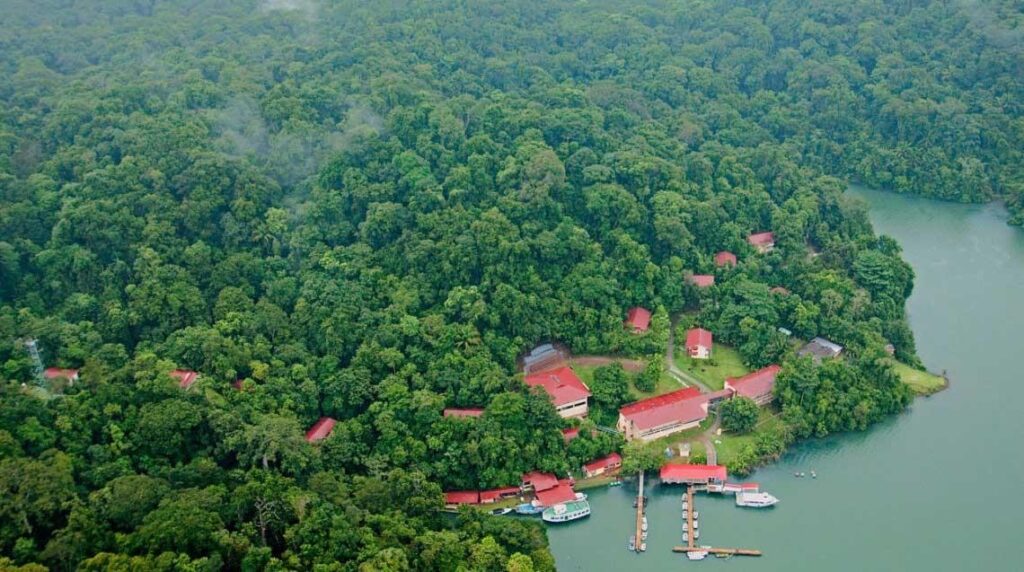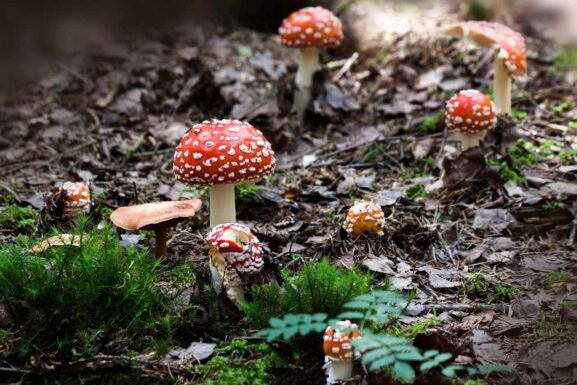A Guide To Sustainable Tourism And Ecotourism In Panama
With its unique geography as a land bridge between two major continents and oceans, Panama’s tropical rainforests have some of the highest levels of biodiversity on Earth packed into a small isthmus.
While Costa Rica is a more well-known and developed ecotourism destination, the advantage of Panama is it isn’t packed full of tourists in high season. The country offers a much more off-the-beaten path experience away from crowds and remains largely free from the big box tourism.
Home to one of the Western Hemisphere’s largest rainforests, Panama makes the ideal outdoor classroom to combine travel with learning about tropical ecology, ocean conservation, sustainability and the importance of forest biodiversity.
Explore an enchanted land of soaring mountains, raging rivers and panoramic ocean vistas that is home to many North and South American species of birds and wildlife.
The Study of Tropical Ecology In Panama

The thick rainforests along the Panama Canal are the most studied tropical forest in the world.
Panama is home to the newly opened Museum of Biodiversity designed by world-famous architect Frank Gehry and the Smithsonian Tropical Research Center, which is the only bureau of the Smithsonian Institution based outside of the United States and is dedicated to understanding the past, present and future of tropical ecosystems and their relevance to human welfare.
The Smithsonian Tropical Research Center grew out of the Barro Colorado Research Station in the Panama Canal Zone, which was established in 1923 and is one of the world’s leading tropical research organizations.
The museum’s facilities provide for long-term ecological studies in the tropics and are used by some 1,200 visiting scientists from academic and research institutions around the world every year.
As part of its ecological efforts, the Panamanian government is committed to developing the ecotourism sector in a sustainable way by working with the nation’s seven indigenous groups.
Panama Wild: A National Geographic Documentary
Learn about the fascinating biodiversity research being done at Barro Colorado island in the Panama Canal region.
Sustainable Tourism In Panama

Looking north of the border to the massive success of Costa Rica’s multi-billion dollar ecotourism industry, Panama launched a five-year, $301 million plan to boost its tourism industry in 2020 called the Sustainable Tourism Development Master Plan.
Recently, Panama launched a community-based tourism portal called SOSTUR where tourists can book unique ecotourism experiences in the country’s indigenous and rural communities in regions that have previously been largely untouched by tourism.
Panama Minister of Tourism Iván X. Eskildsen says, “our ambition is to implement this tourism economic model as an open-source template that contributes to the regeneration of our planet’s ethno- and biodiversity. Because of Panama’s unique characteristics, we believe it is the ideal location to promote and lead this effort.”
Indigenous Ecotourism In Panama

Comprising less than 5% of the world’s population, indigenous people protect 80% of global biodiversity. In Panama, more than 60% the nation’s forest cover lies within Indigenous territories.
The indigenous population of Panama is 12.4% and there are a number of autonomous indigenous comercas where indigenous people are self-governing.
The most accessible of the tribes are the Emberá living in the upper Chagres River valley near the Panama Canal.
Until the 1990s, most of the Emberá peoples lived in an extremely remote section of the Darien Gap’s jungle. Under the leadership of chief Antonio Tocamo, several families migrated to the banks of the Pepueni River in Chagres National Park to establish Parara Puru, a village devoted to demonstrating traditional Emberá culture and providing guided nature hikes that serve as informal, educational discussions about the Emberá way of life.
You will also find the Embera Druá Village on the Chagres River. The Emberá language is not a single language but a group of mutually-intelligible languages spoken throughout Panama and Colombia.
There are 5 comarcas indígenas (indigenous provinces) in Panama. There is the Comarca Emberá-Wounaan in Darien Gap in the south of the country and Guna Yala, which consists of a 380-island Caribbean archipelago and large territory across the central mountain range to the northeast of Panama City. Other comarcas in the south of the country include Kuna de Madugandí and Kuna de Wargandí.
The largest comarca in Panama is the Ngäbe-Buglé Comarca in the Bocas Del Toro archipelago and the Talamanca Mountains in the northeast of the country.
There are two other native groups in the northeast corner of Panama that are in the process of legalizing their comarcas, the Naso and Bribrí.
Most of the tropical rainforests reserves of Panama are located within indigenous territory and the indigenous communities have been given special opportunities to develop ecotourism in harmony with their own land management practices.
The Tropical Flora and Fauna of Panama

Panama is considered one of the world’s best birding destinations, and the amount of wildlife you will see in the tropical rainforests is truly astounding.
While Panama’s northern neighbour Costa Rica is probably the world’s best known ecotourism destination, Panama actually has more species of birds, mammals, and aquatic life because of its unique position as a land bridge between continents.
Panamanians like to joke that you will see ten tourists starting at one bird in Costa Rica and one tourist starting at ten birds in Panama.
Here are the major flora and fauna found in Panama’s tropical rainforests:
- Over 10,000 species of native plants and 1,500 types of trees, many found nowhere else in the world.
- About 1,800 species of tropical fungi have been identified, which mycologists estimate is only 3% of the existing fungal biodiversity making Panama an excellent spot for tropical mushroom foraging.
- Over 1,000 species of birds, including the resplendent quetzal, collared aracari, blue-footed boobys, brown pelican, ornate hawk-eagle, rofous-ventaul, ground cuckoo, toucans, parrots and scarlet macaws.
- The list of mammals is also vast, including the jaguar, brown-throated three-toed sloth, the giant anteater, Geoffroy’s spider monkey, Panamanian white-headed capuchin, Central American squirrel monkey, ocelot, pumas, green iguanas and the capybara.
- There are a variety of different coral reef habitats found in both the Pacific Ocean and Caribbean Sea along the Panamanian coast.
Panama also offers excellent opportunities for whale watching. Humpback whales from both the Northern and Southern hemispheres come to breed and give birth (July–October and December–February are the best times).
In the waters along Panama’s coast, you will find other whales, dolphins, manta rays, hammerhead sharks, whitetip reef sharks, caymans, crocodiles, manatees, turtles and an endless rainbow of exotic tropical fish.
The National Park System in Panama

The Panamanian government has designated 30% of the country as national parks, tropical forest reserves, or wildlife refuges. A total of 2 million hectares (5 million acres) is protected.
There are 18 national parks in Panama – 6 of which are less than a two-hour drive from Panama City.
Since fresh water is crucial for the operation of the Panama Canal, through which where 5% of maritime trade passes, the major watersheds near the canal have been preserved and protected within the national park system making Panama City a great launching point for outdoor adventures.
There are also 27 protected nature reserves with exceptional beauty and trails such as Fortuna Forest Reserve, La Yeguada Forest Reserve, and the Palo Seco Forest Reserve.
The national parks of Panama are administered by the Autoridad Nacional de Ambiente (ANAM) . While access is inexpensive at $3 – $10 for entrance fees and camping permits are only $5, this government agency is underfunded.
As a result, the national park infrastructure such as a ranger stations, eco lodges and trail maps is often lacking. This is one area where Costa Rica is superior, where investment in national park facilities has been a bigger national priority.
Perhaps Panama will give Costa Rica a run for its money in the next decade with a big push into the ecotourism sector.
The country of Panama has so much to offer adventure travellers and they are only just starting to tap into the full potential of natural wonders found across the mountains, jungles and beaches of the spectacular Panamanian isthmus.
Why not make Panama your next destination for ecotourism and sustainable travel!
- 10 Shocking Facts and Statistics About Phone Addiction - March 16, 2025
- Animism And Nonduality: Exploring The Secret Language of Nature - March 12, 2025
- 10 Best Hikes In Tayrona National Park And Sierra Nevada de Santa Marta - March 9, 2025



